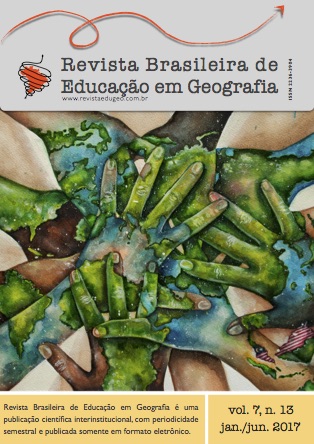CARTOGRAFIA ESCOLAR E INCLUSIVA: construindo pontes entre a universidade, a escola e a comunidade
DOI:
https://doi.org/10.46789/edugeo.v7i13.490Abstract
Esse artigo tem como objetivo apresentar experiências na elaboração de material didático tátil e os procedimentos de aplicação em sala de aula, no âmbito da Disciplina Optativa Cartografia Escolar e Inclusiva, do Curso de Graduação em Geografia (Licenciatura), bem como do Projeto de Extensão Cartografia Tátil e Mapavox da UNESP - Rio Claro – SP. Inicialmente, realizou-se uma contextualização da disciplina e de sua dinâmica, bem como do projeto de extensão, desde os referenciais teóricos balizadores das práticas em sala de aula, até a concepção e elaboração de materiais didáticos inclusivos e de sua aplicação, visando a inclusão de pessoas com deficiência visual. Foram selecionados exemplos de materiais didáticos e aulas formuladas pelos estudantes universitários, para ilustrar o ensino de Cartografia e a elaboração de materiais didáticos táteis inclusivos. Os resultados indicaram que os alunos de Licenciatura em Geografia encontraram na disciplina uma oportunidade de realizar a elaboração de material didático e sua aplicação em sala de aula, por meio de intervenções efetivas e contato direto com pessoas cegas e com baixa visão, o que permitiu um crescimento de todos os participantes, que foram estimulados à elaborar materiais inclusivos norteadores para as práticas em sala de aula.
PALAVRAS-CHAVE
Cartografia escolar. Cartografia tátil. Material didático.
SCHOOL AND INCLUSIVE CARTOGRAPHY: building bridges between university, school and community
ABSTRACT
This article aims to present experiences in the preparation of tactile didactic materials and procedures of application in the classroom, in the context of the discipline Inclusive and School Cartography, in the Geography Undergraduation Course (Bachelor), as well as in the extension project Tactile Cartography and Mapavox from UNESP - Rio Claro SP. In the first moment, it is presented a contextualization of the discipline and its dynamic as well as the extension project, emphasizing the theoretical references and the practical procedures in the classroom, looking for the elaboration of didactic materials and theirs applications, for the inclusion of visually-impaired people. Selected examples of didatic material, such as tactile game and model, and class plans prepared by Geography undergraduation students to illustrate tactile material and inclusive cartography practices are presented. The results indicated that students of Geography had in the discipline an opportunity to perform the preparation and application of inclusive material in the classroom, through effective intervention and direct contact with visually-impaired persons, resulting in a growth of all participants who were encouraged to draw up inclusive materials and to conduct practices in the classroom.
KEYWORDS
School cartography. Tactile cartography. Didactic material.
ISSN: 2236-3904
REVISTA BRASILEIRA DE EDUCAÇÃO EM GEOGRAFIA - RBEG
www.revistaedugeo.com.br - revistaedugeo@revistaedugeo.com.br
Downloads
Downloads
Published
How to Cite
Issue
Section
License
Proposta de Aviso de Direito Autoral Creative Commons
1. Declaro que o presente artigo é original, não tendo sido submetido à publicação em qualquer outro periódico nacional ou internacional, quer seja em parte ou em sua totalidade. Declaro, ainda, que uma vez publicado na Revista Brasileira de Educação em Geografia, o mesmo jamais será submetido por mim ou por qualquer um dos demais co-autores a qualquer outro periódico. E declaro estar ciente de que a não observância deste compromisso submeterá o infrator a sanções e penas previstas na Lei de Proteção de Direitos Autorias (Nº9609, de 19/02/98)
2. A Revista Brasileira de Educação em Geografia tambem segue a "Proposta de Política para Periódicos de Acesso Livre".
Autores que publicam nesta revista concordam com os seguintes termos:
- Autores mantém os direitos autorais e concedem à revista o direito de primeira publicação, com o trabalho simultaneamente licenciado sob a Licença Creative Commons Attribution que permite o compartilhamento do trabalho com reconhecimento da autoria e publicação inicial nesta revista.
- Autores têm autorização para assumir contratos adicionais separadamente, para distribuição não-exclusiva da versão do trabalho publicada nesta revista (ex.: publicar em repositório institucional ou como capítulo de livro), com reconhecimento de autoria e publicação inicial nesta revista.
- Autores têm permissão e são estimulados a publicar e distribuir seu trabalho online (ex.: em repositórios institucionais ou na sua página pessoal) a qualquer ponto antes ou durante o processo editorial, já que isso pode gerar alterações produtivas, bem como aumentar o impacto e a citação do trabalho publicado (Veja O Efeito do Acesso Livre).







